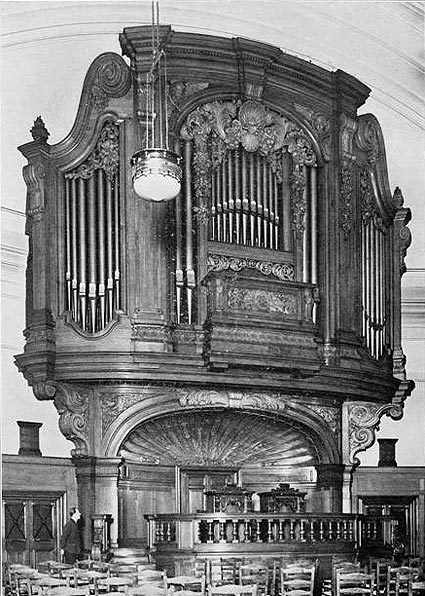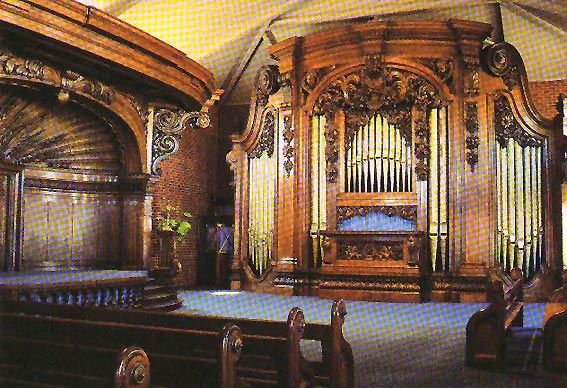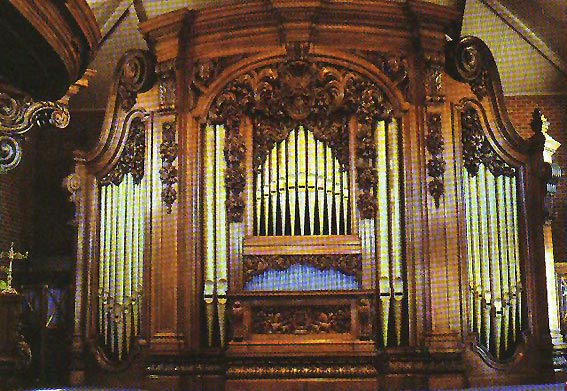The Abbey Restaurant
Federation Square, Nicholls
Organ Façade only
From the Third Church of Christ, Scientist, Curzon Street, London
Norman & Beard 1911

The black & white photograph was taken by Sydney W. Newbery for The Organ, volume X, no 37 (July 1930), p.47
and shows the instrument in its original home at the Third Church of Christ Scientist, Curzon Street, Mayfair, London
where it was attached to the 1911 Norman & Beard organ. [JRM]
The magnificent carved oak organ case, now divided in two sections, was originally built for the Third Church of Christ, Scientist, Curzon Street, Mayfair, London, and graced the 1911 Norman & Beard organ housed in that spacious edifice. Upon redundancy, the case (without the remainder of the organ) was purchased by Australian partners Don Robinson and John and Lynne Anderson, and was installed during 1988 at the Woodoak Museum, Junee, in southern New South Wales. [1] The instrument was transferred to The Abbey Restaurant (a large function and conference centre) in 1995.
According to newspaper reports, the timber used in the case came from oak retrieved from English manor houses and shipwrecks, and was designed by L.F. Roslyn to incorporate biblical images, floral motifs, sheaves of wheat and doves.[2]
The following extract from an article by J. Stuart Archer in The Organ, (Vo1.37, No.9, July 1930), describes more fully the Norman & Beard organ, the building and the organ case:
A Remarkable Organ Case
by J. Stuart Archer
It has been reserved for the Third Church of Christ Scientist in Curzon Street to acquire the most elaborate and interesting piece of case-work that has been made for some time. Before entering on a notice of its details, it is desirable to visualise its surroundings in order that one may be able to appreciate how perfectly it harmonises with the style of architecture. The church is severely simple in design, though exquisitely proportioned, about 130ft by 75ft in ground plan, and 40ft to the centre of the barrel roof. The floor, of hard polished wood, rises by steps from the centre of the church to the back. Round the sides run low galleries (which form part of the building), and under these, outside, is the ambulatory. The acoustics of such a building, as can be imagined, are good; when empty, the resonance of a loud staccato chord lasts six seconds,

The organ stands in a gallery on the north wall above the readers' desks. It was built in 1911 by Messrs Norman & Beard (now Messrs Hill & Son and Norman & Beard), and is an outstandingly successful specimen of their work. Only two manuals were put in at first, the choir organ being added ten years later. Various additions and alterations have been made from time to time; at present the specification stands thus:
| GREAT Double Open Open Diapason (1) Open Diapason (2) Claribel Harmonic Flute Geigen Principal Principal Twelfth-Nazard Fifteenth Mixture Contra Posaune Posaune SWELL Open Diapason Cor de nuit Salicional Vox Angelica Hohl Flöte Gemshorn Flautino Fifteenth Nazard-Mixture Contra Oboe Cornopean Oboe Vox Humana CHOIR Dulciana Harmonic Flute Viol d'orchestre Lieblich Flute Salicetina Clarinet Tuba Gongs PEDAL Open Wood Open Metal Bourdon Octave Bass Flute Violoncello Trombone |
16 8 8 8 4 4 4 2-2/3 2 III 16 8 8 8 8 8 4 4 2 2 II 16 8 8 8 8 8 8 4 2 8 8 8 16 16 16 8 8 8 16 |
(12.17) (l5 in.) (extension of Tuba) |
Usual couplers, including sub and super to swell and choir.
3 pistons to choir; 4 to great; 5 to swell; 4 composition pedals; 2 balanced swell pedals.
Unfortunately, the gallery is too small to admit of a 32ft stop on the pedal, and space could not be found in the choir box for an orchestral oboe. The mixture on the swell is of delicate tone and can be used with the flutes and celeste. Two principals on a great of twelve stops was an unusual feature at the time of their insertion. The large diapason is foundational, and sounds better in the church than at the keyboard; the second one might more correctly be lablled geigen. As wll be seen from the photograph, the plan of the case front is semi-elliptical and is divided into three portions, the centre one containing the bottom eleven notes of the big diapason with two notes of the pedal metal open on each side; the two side panels running back to the wall (which is circular in plan) hold seven pipes each taken from the same stop. From the centre projects a smll gallery in which the singer stands. Over the arch at the top of the centre portion are two cherubs' heads, and under it a grouped mass of carved shells, fruit and flowers, which seems to "boil over" in its profusion and run down the frame work separating the centre from the side pipes. The photograph does not show the richness of detail on the panel in front of the smll gallery, nor does it give the effect of depth in the carving which is so noticeable a feature in the original. At present the oak is somewhat light in colour; time will improve its appearance, and make it harmonise better with the deep bronze colour of the pipework. It is unfortunate that the carving hides so much of the centre pipes. They really reach up to the top of the arch, but as seen now, their mouths are too high up to be in correct proportion to their visible length; and one could wish that it had not been necessary to "beard" the larger pipes. The case was designed by Mr L. Roslyn, and carved by Messrs Samuel Elliott & Sons of Caversham, Reading.
[1] Andrew Kazaar, "40 tonnes of English Oak: a massive organ", The Canberra Times, 26 May 1995, 3. (Supplied by Trevor Bunning).
[2] The Canberra Times, 1 July 1995, p9.
[3] J. Stuart Archer, "A remarkable organ case", The Organ, 37/9, July 1930, 47-48.
